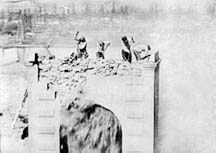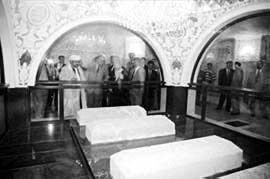|
Autumn 1998 (6.3)
Legend of the
Bibi-Heybat Mosque by Azad Sharifov
Left: The Bibi-Heybat Mosque (1930) Right: The Mosque when it was being destroyed under Stalin's orders (1934). Note the oil fields in the background. The Bibi-Heybat Mosque on the outskirts of Baku has an unusual history. First of all, it was built to honor the sister of the 7th Shiite Imam, Ali, and secondly, when the mosque was destroyed during Stalin's rule, legends arose about a woman wrapped in white disappearing down into the sea who would return when times got better. The legends that have grown up around the Bibi-Heybat Mosque are examples of how such narratives in the minds of the community can influence reality later on. A new Mosque has recently been constructed on the same spot and dedicated in July 1998. When foreigners flocked to Baku during its First Oil Boom at the end of the 19th century, they brought their religious beliefs with them. Although Azerbaijan was traditionally a Muslim country, the country was open and tolerant of other religious practices including Judaism and Christianity. The architectural landscape of Baku soon revealed this religious diversity. Along with palatial residences, community theaters, clubs and music halls, a new wave of mosques, churches and synagogues were built. Along with mosques such as the mosque of Mohammad ibn Abu Bakir, Bibi-Heybat mosque, Friday Mosque, Shirvanshah mosque and the Blue mosque. Other religious sanctuaries included what was known as the Old Church, the Nickolayevski Cathedral, the Spassko-Preobrazhenskaya Church, the German church (Kirke), a Catholic church, and a Jewish synagogue. Also there were several Armenian churches which still stand today but are closed. In the 1930s, Stalin began his campaign to ban religious practices and ordered the widespread destruction of religious buildings. The first target in Baku was the Bibi-Heybat mosque, followed by the large Alexander Nevski cathedral and several Christian churches which were dynamited shortly thereafter. Other worship centers were converted into museums or workshops or were used for storage.
Allegedly, the Imam's sister, Okuma Khanim (Mrs. Okuma), fled to Baku and, in order not to attract attention, settled along the shore of the Caspian Sea. There she led the life of a holy woman. After her death, the people erected a small crypt over her grave. Years passed, and rumors about the grave of a holy woman from Mohammad's family spread throughout the East. The site was declared a "pir," or holy place. Religious people, particularly sheiks, began to settle near the site and the village was given the name Sheikhovo and later Shikhovo. Pilgrims from distant Muslim countries were said to have come to visit Okuma Khanim's grave. Eventually, a small mosque was built with one room which had an inscription that read: "Built by Mahmud ibn Saad." Another plaque indicated that the mosque had been built between 663 and 665 (Hazri) or 1264-1266 according to the Western calendar. The interior of the mosque was decorated with blue tile. A crystal lamp was suspended from the ceiling. When the strong Baku winds started to blow, the crystals would hit against each other and make tinkling sounds. The mosque had a 20-meter-high minaret from which the "ozan" used to call out the invitation to prayer. Forty stone steps led from the mosque to the nearby pier where foreign ships docked. The name given to the mosque was Bibi-Heybat because in those days it was not proper to call a woman by her first name. Okuma Khanim had a devoted servant named Heybat. In Azeri "bibi" means "aunt," so calling the mosque "Bibi-Heybat" was the same as saying "the mosque of Heybat's aunt," rather than blatantly saying, "Okuma Khanim's Mosque." In 1903, an artist made a painting of the mosque. An Englishman liked it and persuaded the artist to sell it to him. But, allegedly, the famous Azerbaijani Oil Baron Taghiyev found out and bought back the painting from the Englishman so that it could stay in Azerbaijan. During the Bolshevik Revolution (1920) when all of the Taghiyev's property was confiscated, the painting disappeared. Then 44 years later in 1964 and after Stalin had died, someone anonymously donated the painting to the Art Museum of Azerbaijan. Today, it is still on exhibit there. Blowing Up the Mosque Another strange phenomenon is associated with the mosque. Two nights after it was demolished, the people of the village had trouble sleeping, outraged that their holy place had been desecrated. When dawn broke, hearing shouts and a loud crash, they ran to the mosque. A Red Army soldier, who was supposed to be guarding the remnants of the mosque, stood there with eyes wide open in horror, pointing to the sea and shouting something unintelligible. Where he pointed, the people could see a woman wrapped in a white veil walking down to the sea. The vision of the woman disappeared into the red rays of the rising sun and the glistening water. At least, that's how the legend goes. An old man whispered: "She is sure to come back! She'll return in better times." The soldier went on to describe how he had been awakened by the sound of stones crashing down on one another. It was as if someone were moving them. Then he had seen the tiny thin form of a woman dressed in white rising from the rubble. When she passed by him, he could detect the smell of fresh roses. (In Azerbaijan, it is customary to wash the hands and face of the deceased with gulab or rosewater.) Yet another legend says that the soldiers who were involved in Bibi-Heybat's destruction died in freak accidents. One of them allegedly drowned, another died when a boulder fell on his head, a third one was electrocuted. While it may be difficult to separate fact from fiction, it's clear that Bibi-Heybat has remained significant to the Azerbaijani people. Maybe these stories were created to cope with the disturbing fact that their holy place had been desecrated and it was their way of revenging the destruction and creating a mental construct of justice when they could not, indeed, retaliate and defend their faith in reality. But what is curious today is that more than 60 years after its destruction, the Bibi-Heybat Mosque has been rebuilt. A dedication ceremony, attended by President Heydar Aliyev, was held on July 11, 1997. Regardless of whether the stories are true or not, clearly the fact that the mosque had lived on in the memories of the Azerbaijani people through legends has clearly contributed to making the building become a reality once again. Could it be, as predicted, that better times really have returned? Azad Sharifov is head of
the Journalism Department of the Higher Diplomacy College of
Azerbaijan. Back to Index
AI 6.3 (Autumn 1998) |



